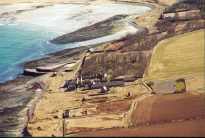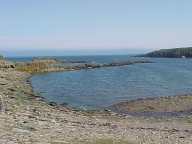|
||
|
Harbours
CASTLEHILL HARBOUR James Traill was educated in Marischal College, Aberdeen and studied Law in Edinburgh. In 1788 he became Sheriff-Depute and subsequently Sheriff of Caithness. After Traill purchased Castlehill House, he built roads and established the flagstone industry at Castlehill quarry.
The harbour was built to ship flagstone, the first shipment being in
1825. In 1856 output was 7112 tons. the industry peaked in
1902 when 35,363 tons was produced by 500 employees. This fine harbour was reputed to be built by very few men using shearlegs. slabs were quarried at low tide, tied to large timbers with chains and floated into the basin and then positioned using shearlegs. Bremner's theory was that slabs placed upright had greater resistance to wave action. boom gates at the entrance were used to enable excavation of the pumped out harbour basin and to control the run of water into the harbour when vessels were loading and unloading. the harbour is now administered by a trust. More About Castlehill
HAM HARBOUR The inlet was first mentioned in 1725 as a place used by small trading vessels. In 1700 Captain James Moodie of Melsetter owned the public ferry between Hoy, Orkney and Rattar in Caithness. the boat would land at Ham or Scarfskerry, whichever was most convenient. By 1791 the first improvements to the natural inlet were described in the
Old Statistical Account for Dunnet which records: This ruined harbour is an interesting place to visit and is a favourite spot for picnics. More about Ham
DWARWICK PIER AND SLIPWAY Severe storms washed away the lower slipway and pier during the winters of 1969/70. Dwarwick Pier Association was formed and improvements were undertaken with assistance from various agencies. The area is an attraction to a large number of local people and tourists. It is a favourite place to launch small boats, fish off the end of the pier in relatively deep water, skin dive, go surfing, picnic or park a car prior to exploring the area or walking on Dunnet hill. More about Dwarwick
BROUGH SLIPWAY The stone built slipway and adjacent store were built in 1830 by the Northern Lighthouse Board when the lighthouse was being constructed at Dunnet Head by Robert Stevenson. Stores arrived at Brough slipway and were taken to the lighthouse by horse drawn carts. Local fishermen made their living here fishing for cod, ling and shellfish. at the turn of the century, Brough fishwives used to walk 12 miles to Thurso carrying the catch to sell at the Auld Fishstane.
The slipway access road and environs are now owned by the Brough Bay
Association formed in 1976. |
||


